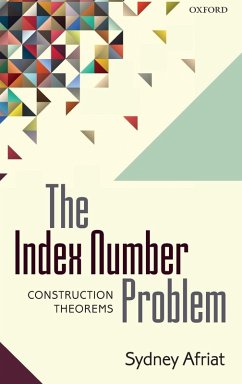Afriat
Index Number Problem C
Afriat
Index Number Problem C
- Gebundenes Buch
- Merkliste
- Auf die Merkliste
- Bewerten Bewerten
- Teilen
- Produkt teilen
- Produkterinnerung
- Produkterinnerung
This volume addresses the search for a true price index, the need to know how to convert an amount at one date into the right amount at another date. The longstanding question concerning how such an index should be constructed is known as 'The Index Number Problem'.
Andere Kunden interessierten sich auch für
![Practical Guide to Price Index and Hedonic Techniques Practical Guide to Price Index and Hedonic Techniques]() Ana M AizcorbePractical Guide to Price Index and Hedonic Techniques92,99 €
Ana M AizcorbePractical Guide to Price Index and Hedonic Techniques92,99 €![Number Go Up Number Go Up]() Zeke FauxNumber Go Up12,99 €
Zeke FauxNumber Go Up12,99 €![Report Number I, the Natural Resources Survey of the Conservation and Natural Resources Commission of New Mexico Report Number I, the Natural Resources Survey of the Conservation and Natural Resources Commission of New Mexico]() Report Number I, the Natural Resources Survey of the Conservation and Natural Resources Commission of New Mexico29,99 €
Report Number I, the Natural Resources Survey of the Conservation and Natural Resources Commission of New Mexico29,99 €![West Virginia Directory of Industries Giving Name of Firm, Location, Nature of Business and Number of Employees West Virginia Directory of Industries Giving Name of Firm, Location, Nature of Business and Number of Employees]() West Virginia Directory of Industries Giving Name of Firm, Location, Nature of Business and Number of Employees27,99 €
West Virginia Directory of Industries Giving Name of Firm, Location, Nature of Business and Number of Employees27,99 €![Number Go Up Number Go Up]() Zeke FauxNumber Go Up21,99 €
Zeke FauxNumber Go Up21,99 €![The Practical Arithmetic: Designed for Such Institutions As Require a Greater Number of Examples Than Are Given in the Elementary Arithmetic The Practical Arithmetic: Designed for Such Institutions As Require a Greater Number of Examples Than Are Given in the Elementary Arithmetic]() George Roberts PerkinsThe Practical Arithmetic: Designed for Such Institutions As Require a Greater Number of Examples Than Are Given in the Elementary Arithmetic34,99 €
George Roberts PerkinsThe Practical Arithmetic: Designed for Such Institutions As Require a Greater Number of Examples Than Are Given in the Elementary Arithmetic34,99 €![Corn Tables, Shewing the Cost of Any Number of Quarters and Bushels, From Ten Shillings to Eighty Shillings Per Quarter Corn Tables, Shewing the Cost of Any Number of Quarters and Bushels, From Ten Shillings to Eighty Shillings Per Quarter]() William Thomas NedhamCorn Tables, Shewing the Cost of Any Number of Quarters and Bushels, From Ten Shillings to Eighty Shillings Per Quarter29,99 €
William Thomas NedhamCorn Tables, Shewing the Cost of Any Number of Quarters and Bushels, From Ten Shillings to Eighty Shillings Per Quarter29,99 €-
-
-
This volume addresses the search for a true price index, the need to know how to convert an amount at one date into the right amount at another date. The longstanding question concerning how such an index should be constructed is known as 'The Index Number Problem'.
Produktdetails
- Produktdetails
- Verlag: Oxford University Press
- Seitenzahl: 236
- Erscheinungstermin: 15. April 2014
- Englisch
- Abmessung: 239mm x 160mm x 23mm
- Gewicht: 499g
- ISBN-13: 9780199670581
- ISBN-10: 0199670587
- Artikelnr.: 39395478
- Herstellerkennzeichnung
- Libri GmbH
- Europaallee 1
- 36244 Bad Hersfeld
- gpsr@libri.de
- Verlag: Oxford University Press
- Seitenzahl: 236
- Erscheinungstermin: 15. April 2014
- Englisch
- Abmessung: 239mm x 160mm x 23mm
- Gewicht: 499g
- ISBN-13: 9780199670581
- ISBN-10: 0199670587
- Artikelnr.: 39395478
- Herstellerkennzeichnung
- Libri GmbH
- Europaallee 1
- 36244 Bad Hersfeld
- gpsr@libri.de
Sydney Afriat was awarded a State Bursary at school for two years at Pembroke College, Cambridge. He graduated in mathematics and part physics and spent an interval during WWII at the National Physical Laboratory, Teddington, High Speed Section, Aerodynamics Division, directed by J. H. C. He was released at end of the war and whilst studying for his DPhil at Queen's College, Oxford, he became research assistant to the economist J. R. Bellerby, and then joined the Department of Applied Economics at Cambridge. He has held positions at many universities including Jerusalem, Princeton, Rice, Yale, Purdue, UNC, Waterloo, Ottawa, and Berkeley. He has been Visiting Fellow at All Souls, Oxford, Izaak Walton Killam Memorial Fellow, an Academic Visitor at the London School of Economics, Visiting Fellow at Macquarie University NSW, Visiting Professor at the Institute of Social and Economic Research, Osaka and at the University of Siena, and Jean Monnet Fellow at the European University Institute.
* Preface
* Acknowledgements
* Introduction
* I The Index Number Problem
* I: The New Formula
* II: The Power Algorithm
* III: Combinatorics
* IV: Consistency
* V: Illustration
* Bibliography
* II Construction Theorems
* > xs - xr
* 2: Principles of Choice and Preference
* 3: Utility construction-revisited
* 4: The construction of separable utility functions from expenditure
data
* 5: The Connection between Demand and Utility
* 6: Revealed Preference Revealed
* Appendix: Terminology
* Appendix 1. Constant returns, conical, homogeneous
* Appendix 2. Notation
* Appendix 3. Cost Efficient, Cost Effective
* Appendix 4. Part, Chapter, Section
* Note: RES 2011 Conference Preliminary to 'Afriat's Theorem and the
Index Number Problem'
* Acknowledgements
* Introduction
* I The Index Number Problem
* I: The New Formula
* II: The Power Algorithm
* III: Combinatorics
* IV: Consistency
* V: Illustration
* Bibliography
* II Construction Theorems
* > xs - xr
* 2: Principles of Choice and Preference
* 3: Utility construction-revisited
* 4: The construction of separable utility functions from expenditure
data
* 5: The Connection between Demand and Utility
* 6: Revealed Preference Revealed
* Appendix: Terminology
* Appendix 1. Constant returns, conical, homogeneous
* Appendix 2. Notation
* Appendix 3. Cost Efficient, Cost Effective
* Appendix 4. Part, Chapter, Section
* Note: RES 2011 Conference Preliminary to 'Afriat's Theorem and the
Index Number Problem'
* Preface
* Acknowledgements
* Introduction
* I The Index Number Problem
* I: The New Formula
* II: The Power Algorithm
* III: Combinatorics
* IV: Consistency
* V: Illustration
* Bibliography
* II Construction Theorems
* > xs - xr
* 2: Principles of Choice and Preference
* 3: Utility construction-revisited
* 4: The construction of separable utility functions from expenditure
data
* 5: The Connection between Demand and Utility
* 6: Revealed Preference Revealed
* Appendix: Terminology
* Appendix 1. Constant returns, conical, homogeneous
* Appendix 2. Notation
* Appendix 3. Cost Efficient, Cost Effective
* Appendix 4. Part, Chapter, Section
* Note: RES 2011 Conference Preliminary to 'Afriat's Theorem and the
Index Number Problem'
* Acknowledgements
* Introduction
* I The Index Number Problem
* I: The New Formula
* II: The Power Algorithm
* III: Combinatorics
* IV: Consistency
* V: Illustration
* Bibliography
* II Construction Theorems
* > xs - xr
* 2: Principles of Choice and Preference
* 3: Utility construction-revisited
* 4: The construction of separable utility functions from expenditure
data
* 5: The Connection between Demand and Utility
* 6: Revealed Preference Revealed
* Appendix: Terminology
* Appendix 1. Constant returns, conical, homogeneous
* Appendix 2. Notation
* Appendix 3. Cost Efficient, Cost Effective
* Appendix 4. Part, Chapter, Section
* Note: RES 2011 Conference Preliminary to 'Afriat's Theorem and the
Index Number Problem'









